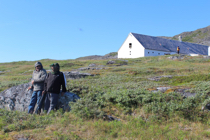Going Home to Hebron
March 2017
Jerry Tuglavina was born 71 years ago in Hebron on the Labrador North Coast in what is now known as Nunatsiavut. He was just 13-years-old when the community was relocated in the 1950s, but he still remembers well his life there with his family.
“What was most memorable to me, and most people who lived in Hebron, is going home at Christmastime,” explains Tuglavina who returned home to Hebron for the first time in over a decade last summer with the Hebron Family Archeology Project. “We hardly spent any time at all in Hebron; most of the year we’d be out at the outposts fishing or netting seals. My grandfather had three homes back then, one for each season. We’d all go to Hebron around Christmastime each year for a big celebration and stay until the spring.”
Tuglavina lived in Hebron with his Grandparents and three other siblings. They ate a diet of largely wild food and spent much of the year in fishing and hunting camps. He says that each year about 200 people would come to Hebron from sealing camps all around the surrounding region to spend the winter. It would be the first time seeing each other sometimes for months.
For the most part, outside of Them Days, stories of Hebron have remained largely oral but now as fewer of the original Hebron residents remain, Tuglavina believes that it is important to record these stories while it is still possible. That’s why he traveled with Tradition & Transition researcher Michelle Davies for the Hebron Family Archeology Project, to record where the houses were once located and who lived where. Davies, who works as an archeologist with the Nunatsiavut Government’s Departure of Culture and PhD candidate at Memorial University, is organizing the project with guidance from a steering committee of former Hebron residents to determine what was important for them to record. The Hebron Selection Committee chose Tuglavina and Elder John Jararuse to travel to Hebron last summer.
“I’ve been here [in Nunatsiavut] for three years now and Hebron was something that I heard very early on as being important to people from Nunatsiavut,” says Davies. “I always wanted to find an opportunity to connect people through archeology. So I feel really lucky that this opportunity came up with Tradition & Transition to really develop the project because I had heard for so long that people really wanted to see this research done.”
Davies, Tuglavina, and Jararuse, who also lived in Hebron as a boy, traveled together to the former community. Davies said when they first arrived she took out a number of maps and said they could begin surveying the area and writing it all down. She says the Elders gave her a funny look and said “that’s not how you live off the Land, not with maps.” They then guided Davies about the remains of the community remembering details and stories.
“It’s a real familiar place, just the same as when we left it, only no houses. All the landmarks are still there,” says Tuglavina. “There aren’t many of us anymore [from Hebron]. We left as young kids but when we went up to Hebron [this time] it brought back a lot of memories.”
Along with some of the oldest techniques for mapping out an area, Davies employed some of the most modern as well. With the help of Memorial archeologist Pete Whitridge, another Tradition & Transition researcher, working at a nearby archeological site at Johannes Point, Davies was able to employ the use of an aerial drone.
“By flying the drone back and forth,” Davies explains, “you can capture multiple overlapping images, which you can then stitch together on the computer. We did that here in Nain, which has given us a beautifully detailed map that you can manipulate. Because it's in 3D, you can also see the outlines of cabins and some of the houses which have collapsed. It could help us to locate more structures if we need to.”
As an archeologist, Davies says she feels fortunate to be able to participate in a project like this and hear firsthand the stories of the people who lived and experienced the place that she is studying. It is these living memories that the Hebron Family Archeology Project seeks to record. The stories from the people that once called this place home bring nuance and understanding to the relationships and way of life of Hebron that no other could.
“It was amazing to see John and Jerry working together and figuring out where each of these houses stood, or which way they were oriented, or where the porch was, and who lived there, and who lived there after them, and who rented this spot out. They brought back a lot of information and memories that way,” says Davies, who at first planned to get the descriptions of maybe five or six houses but in the end they recorded close to 40. “It’s pretty special to witness those memories resurface because we were in the place, because we were in Hebron.”
For Tuglavina he wants to see the stories of his hometown recorded so that younger generations can learn about his way of life and the history of Nunatsiavut. “If we don’t record them now they’ll be gone for good, we don’t want to lose them,” says Tuglavina, “It was a real special project to take part in.”
This Spring Davies plans on having more community consultations with the Hebron Selection Committee in order to select new people to return to Hebron for the project this coming summer. Davies says that she hope to bring back a family; someone who used to live there, and their children and grandchildren, she says that the impact and memory of Hebron spans generations.





